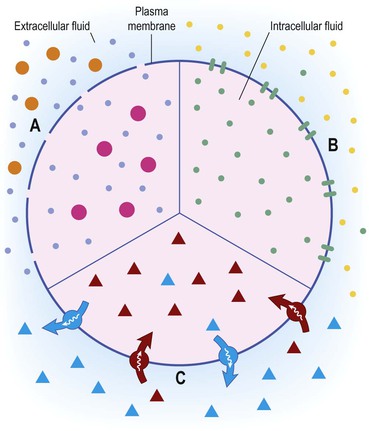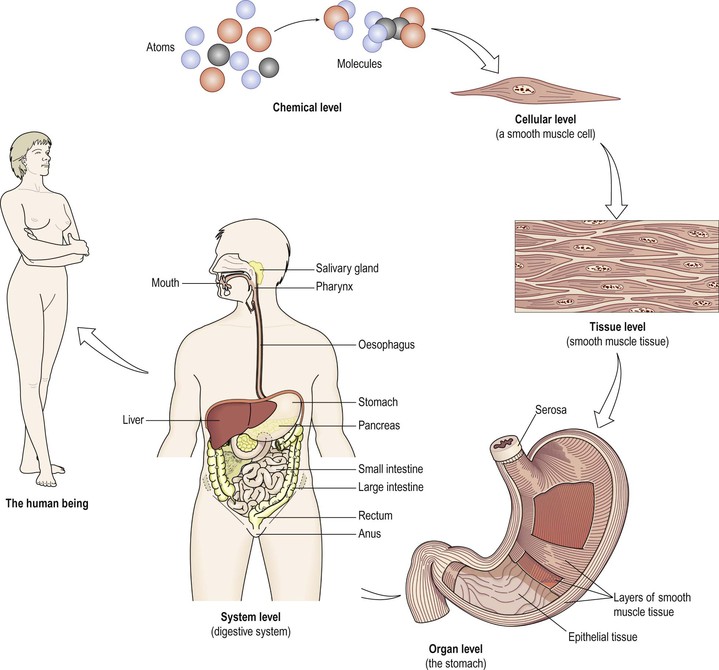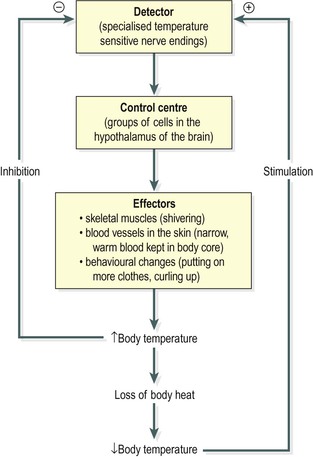Chapter 1
Introduction to the human body
Levels of structural complexity
The internal environment and homeostasis
Introduction to the study of illness
![]() Animations
Animations
Anatomy is the study of the structure of the body and the physical relationships between its constituent parts. Physiology is the study of how the body systems work, and the ways in which their integrated activities maintain life and health of the individual. Pathology is the study of abnormalities and pathophysiology considers how they affect body functions, often causing illness.
Most body systems become less efficient with age. Physiological decline is a normal part of ageing and should not be confused with illness or disease although some conditions do become more common in older life. Maintaining a healthy lifestyle can not only slow the effects of ageing but also protect against illness in later life. The general impact of ageing is outlined in this chapter and the effects on body function are explored in more detail in later chapters.
The final section of this chapter provides a framework for studying diseases, an outline of mechanisms that cause disease and some common disease processes. Building on the normal anatomy and physiology, a systems approach is adopted to consider common illnesses at the end of the later chapters.
Levels of structural complexity
Within the body are different levels of structural organisation and complexity. The most fundamental of these is chemical. Atoms combine to form molecules, of which there is a vast range in the body. The structures, properties and functions of important biological molecules are considered in Chapter 2.
Cells are the smallest independent units of living matter and there are trillions of them within the body. They are too small to be seen with the naked eye, but when magnified using a microscope different types can be distinguished by their size, shape and the dyes they absorb when stained in the laboratory. Each cell type has become specialised, enabling it to carry out a particular function that contributes to body needs. Figure 1.1 shows some highly magnified nerve cells. The specialised function of nerve cells is to transmit electrical signals (nerve impulses); these are integrated and co-ordinated allowing the millions of nerve cells in the body to provide a rapid and sophisticated communication system. In complex organisms such as the human body, cells with similar structures and functions are found together, forming tissues. The structure and functions of cells and tissues are explored in Chapter 3.
Organs are made up of a number of different types of tissue and have evolved to carry out a specific function. Figure 1.2 shows that the stomach is lined by a layer of epithelial tissue and that its wall contains layers of smooth muscle tissue. Both tissues contribute to the functions of the stomach, but in different ways.
Systems consist of a number of organs and tissues that together contribute to one or more survival needs of the body. For example the stomach is one of several organs of the digestive system, which has its own specific function. The human body has several systems, which work interdependently carrying out specific functions. All are required for health. The structure and functions of the body systems are considered in later chapters. ![]() 1.1
1.1
The internal environment and homeostasis
The external environment surrounds the body and is the source of oxygen and nutrients required by all body cells. Waste products of cellular activity are eventually excreted into the external environment. The skin (Ch. 14) provides an effective barrier between the body tissues and the consistently changing, often hostile, external environment.
The internal environment is the water-based medium in which body cells exist. Cells are bathed in fluid called interstitial or tissue fluid. They absorb oxygen and nutrients from the surrounding interstitial fluid, which in turn has absorbed these substances from the circulating blood. Conversely, cellular wastes diffuse into the bloodstream via the interstitial fluid, and are carried in the blood to the appropriate excretory organ.
Each cell is enclosed by its plasma membrane, which provides a selective barrier to substances entering or leaving. This property, called selective permeability, allows the cell (plasma) membrane (see p. 32) to control the entry or exit of many substances, thereby regulating the composition of its internal environment; several mechanisms are involved. Particle size is important as many small molecules, e.g. water, can pass freely across the membrane while large ones cannot and may therefore be confined to either the interstitial fluid or the intracellular fluid (Fig. 1.3A). Pores or specific channels in the plasma membrane admit certain substances but not others (Fig. 1.3B). The membrane is also studded with specialised pumps or carriers that import or export specific substances (Fig. 1.3C). Selective permeability ensures that the chemical composition of the fluid inside cells is different from the interstitial fluid that bathes them.

Figure 1.3 Role of cell membrane in regulating the composition of intracellular fluid. A. Particle size. B. Specific pores and channels. C. Pumps and carries.
Homeostasis
The composition of the internal environment is tightly controlled, and this fairly constant state is called homeostasis. Literally, this term means ‘unchanging’, but in practice it describes a dynamic, ever-changing situation where a multitude of physiological mechanisms and measurements are kept within narrow limits. When this balance is threatened or lost, there is a serious risk to the well-being of the individual. Box 1.1 lists some important physiological variables maintained within narrow limits by homeostatic control mechanisms.
Control systems
Homeostasis is maintained by control systems that detect and respond to changes in the internal environment. A control system has three basic components: detector, control centre and effector. The control centre determines the limits within which the variable factor should be maintained. It receives an input from the detector, or sensor, and integrates the incoming information. When the incoming signal indicates that an adjustment is needed, the control centre responds and its output to the effector is changed. This is a dynamic process that allows constant readjustment of many physiological variables. Nearly all are controlled by negative feedback mechanisms. Positive feedback is much less common but important examples include control of uterine contractions during childbirth and blood clotting.
Negative feedback mechanisms (Fig. 1.4)
Negative feedback means that any movement of such a control system away from its normal set point is negated (reversed). If a variable rises, negative feedback brings it down again and if it falls, negative feedback brings it back up to its normal level. The response to a stimulus therefore reverses the effect of that stimulus, keeping the system in a steady state and maintaining homeostasis.

Figure 1.4 Example of a negative feedback mechanism: control of room temperature by a domestic boiler.
Control of body temperature is similar to the non-physiological example of a domestic central heating system. The thermostat (temperature detector) is sensitive to changes in room temperature (variable factor). The thermostat is connected to the boiler control unit (control centre), which controls the boiler (effector). The thermostat constantly compares the information from the detector with the preset temperature and, when necessary, adjustments are made to alter the room temperature. When the thermostat detects the room temperature is low, it switches the boiler on. The result is output of heat by the boiler, warming the room. When the preset temperature is reached, the system is reversed. The thermostat detects the higher room temperature and turns the boiler off. Heat production from the boiler stops and the room slowly cools as heat is lost. This series of events is a negative feedback mechanism that enables continuous self-regulation, or control, of a variable factor within a narrow range.
Body temperature is one example of a physiological variable controlled by negative feedback (Fig. 1.5). When body temperature falls below the preset level (close to 37°C), this is detected by specialised temperature sensitive nerve endings in the hypothalamus of the brain, where the body’s temperature control centre is located. This centre then activates mechanisms that raise body temperature (effectors). These include:
• stimulation of skeletal muscles causing shivering
• behavioural changes, e.g. we put on more clothes or curl up.
When body temperature rises within the normal range again, the temperature sensitive nerve endings are no longer stimulated, and their signals to the hypothalamus stop. Therefore, shivering stops and blood flow to the peripheries returns to normal.
Most of the homeostatic controls in the body use negative feedback mechanisms to prevent sudden and serious changes in the internal environment. Many more of these are explained in the following chapters.
Positive feedback mechanisms
There are only a few of these cascade or amplifier systems in the body. In positive feedback mechanisms, the stimulus progressively increases the response, so that as long as the stimulus is continued the response is progressively amplified. Examples include blood clotting and uterine contractions during labour.
During labour, contractions of the uterus are stimulated by the hormone oxytocin. These force the baby’s head into the uterine cervix stimulating stretch receptors there. In response to this, more oxytocin is released, further strengthening the contractions and maintaining labour. After the baby is born the stimulus (stretching of the cervix) is no longer present so the release of oxytocin stops (see Fig. 9.5, p. 221).
Homeostatic imbalance
This arises when the fine control of a variable factor in the internal environment is inadequate and its level falls outside the normal range. If the control system cannot maintain homeostasis, an abnormal state develops that may threaten health, or even life itself. Many such situations, including effects of abnormalities of the physiological variables in Box 1.1, are explained in later chapters.
Survival needs of the body
By convention, body systems are described separately in the study of anatomy and physiology, but in reality they work interdependently. This section provides an introduction to body activities, linking them to survival needs (Table 1.1). The later chapters build on this framework, exploring human structure and functions in health and illness using a systems approach.
Communication
In this section, transport and communication are considered. Transport systems ensure that all body cells have access to the very many substances required to support them, as well as providing a means of excretion of wastes; this involves the blood and the cardiovascular and lymphatic systems.
All communication systems involve receiving, collating and responding to appropriate information. There are different systems for communicating with the internal and external environments. Internal communication involves mainly the nervous and endocrine systems; these are important in the maintenance of homeostasis and regulation of vital body functions. Communication with the external environment involves the special senses, and verbal and non-verbal activities, and all of these also depend on the nervous system.
Transport systems
Blood (Ch. 4)
The blood transports substances around the body through a large network of blood vessels. In adults the body contains 5 to 6 litres of blood. It consists of two parts – a fluid called plasma and blood cells suspended in the plasma.







